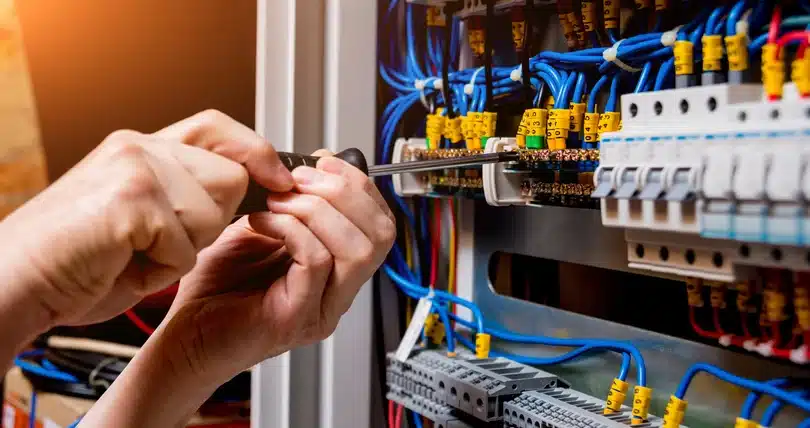GFCIs are required by the National Electrical Code (NEC) to be installed in certain locations, such as bathrooms, kitchens, garages, and outdoor areas. They are also recommended for use in other areas where there is a risk of electrical shock, such as laundry rooms and workshops.
Table of contents
- What is a GFCI
- How does a GFCI outlet work?
- What are the types of GFCIs?
- What is a GFCI used for?
- How to test a GFCI
- How to reset a GFCI
- What is a Ground Fault?
- How to eliminate ground fault accidents?
- Where should GFCIs be installed?
- How should GFCIs be tested?
- What is nuisance tripping of a GFCI?
- How to care for GFCI outlets
- Can I Install GFCIs Myself?
- Conclusion
- FAQs
What is a GFCI
A GFCI (ground fault circuit interrupter) is a safety device that shuts off the flow of electricity to an outlet if it detects a leak to ground. This can help prevent electrical shock, which can be fatal. GFCIs are required in all new homes and are also recommended for older homes, especially in bathrooms, kitchens, garages, and outdoor areas.
How does a GFCI outlet work?
GFCIs works by monitoring the electrical current flowing through a circuit and shutting off the power if it detects a ground fault.. A ground fault is an unintended electrical path to the ground, which can occur when a wire becomes damaged or when water or other conductive material comes into contact with an electrical device.
If there is a difference in the amount of electricity flowing in and out, the GFCI will trip and shut off the power to the outlet.
This can happen if there is a leak to ground, which is when electricity is flowing through a path that it is not supposed to, such as through a person’s body.
GFCIs are very fast-acting and can shut off the power to an outlet in less than 30 milliseconds. This is fast enough to prevent a person from being seriously injured or killed by an electrical shock.
Related Post: Top 30 inspirational commercials that sold out their products
What are the types of GFCIs?
There are two main types of GFCIs: receptacle GFCIs and circuit breaker GFCIs.
Receptacle GFCIs are installed directly into an outlet. They are the most common type of GFCI and are easy to install.
Circuit breaker GFCIs are installed in the electrical panel and protect all of the outlets on a circuit. They are not as common as receptacle GFCIs, but they can be a good option for older homes that do not have GFCIs installed in all of the outlets.
What is a GFCI used for?
GFCIs are typically installed in areas where electrical equipment is likely to come into contact with water, such as kitchens, bathrooms, and laundry rooms. They are also sometimes installed in outdoor areas, such as garages and patios. GFCIs can be installed as outlets or as circuit breakers.
Some of the benefits of using GFCIs include:
Reduces the risk of electrical shock. GFCIs are designed to shut off the power before a person can receive a dangerous electrical shock.
Prevents electrical fires. GFCIs can also help to prevent electrical fires by shutting off the power if there is a ground fault.
Protects property. GFCIs can help to protect your property from damage caused by electrical fires.
If you are not sure whether or not your outlets are protected by GFCIs, you can check them for a “Test” and “Reset” button. If you have any concerns about your electrical system, you should contact a qualified electrician.
How to test a GFCI
It is important to test GFCIs regularly to make sure they are working properly. To test a GFCI, press the “Test” button. The outlet should shut off. If it does not, the GFCI needs to be replaced.
Related Post: How Sump Pumps Work | Full Guide and Details
How to reset a GFCI
If a GFCI trips, you can reset it by pressing the “Reset” button. The outlet should turn back on. If it does not, the GFCI needs to be replaced.
What is a Ground Fault?
A ground fault is an unintentional electrical connection between an energized conductor and ground. This can happen when the insulation on a wire breaks down, or when a metal object comes into contact with an energized wire.
Ground faults can cause serious injuries or death, depending on the amount of current that flows through the body. The severity of the shock depends on several factors, including the amount of current, the path of the current through the body, and the duration of the shock.
How to eliminate ground fault accidents?
There are several ways to eliminate ground fault accidents, including:
Using ground fault circuit interrupters (GFCIs). GFCIs are devices that detect a ground fault and shut off the power to the circuit within milliseconds. GFCIs are required in all bathrooms, kitchens, and garages, as well as outdoors.
Using properly grounded outlets. Grounded outlets have a third prong that connects to the ground wire in the electrical system. The ground wire provides a safe path for the current to flow to the ground in case of a ground fault.
Inspecting electrical cords and appliances regularly. Look for frayed or damaged wires, and replace any appliance that has a damaged cord.
Not using electrical appliances in wet conditions. Water can conduct electricity, and using an appliance in wet conditions increases the risk of a ground fault.
Wearing rubber-soled shoes when working with electricity. Rubber soles help to insulate you from the ground and reduce the risk of a shock.
Turning off the power to a circuit before working on it. This will help to prevent accidental shocks.
Related Post: How to Get Rust Off Stainless Steel
Where should GFCIs be installed?
GFCIs should be installed in any location where water and electricity are likely to come into contact, such as:
Kitchens: Near sinks, dishwashers, garbage disposals, and refrigerators
Bathrooms: Near sinks, bathtubs, showers, and toilets
Laundry rooms: Near washing machines and dryers
Garages: Near workshop areas, power tools, and outdoor outlets
Outdoors: Near swimming pools, hot tubs, and outdoor lighting
How should GFCIs be tested?
GFCIs should be tested monthly to ensure they are in working order. To test a GFCI, follow these steps:
Press the TEST button. The GFCI should trip, cutting off power to the outlet.
Press the RESET button. Power should be restored to the outlet.
If the GFCI does not trip when you press the TEST button, or if it does not reset after you press the RESET button, the GFCI is faulty and needs to be replaced.
Related Post: How to Clean a DVD | Full Guide
What is nuisance tripping of a GFCI?
Nuisance tripping occurs when a GFCI trips unnecessarily, disrupting the flow of electricity to an outlet or circuit. This can be caused by a variety of factors, including:
Ground faults: A ground fault occurs when there is an unintended leakage of electricity to ground. This can be caused by a damaged appliance, a loose connection, or water intrusion.
Ground loops: A ground loop occurs when there is more than one path to ground for an electrical current. This can cause the GFCI to sense a false ground fault and trip unnecessarily.
Harmonic distortion: Harmonic distortion occurs when the quality of the electrical power is poor. This can cause the GFCI to misinterpret the waveform of the current and trip unnecessarily.
Related Post: Wake Robin: All You Need To Know About The Plants
How to care for GFCI outlets
Test GFCIs monthly: Press the “TEST” button on each GFCI outlet to make sure it is working properly. The outlet should trip and the “RESET” button should pop out. Press the “RESET” button to restore power to the outlet.
Reset GFCIs if they trip: If a GFCI outlet trips, it means that it has detected a ground fault. Press the “RESET” button to restore power to the outlet. If the outlet trips frequently, there may be a problem with the outlet or the wiring. Consult an electrician to have the outlet checked.
Avoid plugging damaged cords into GFCIs: Damaged cords can cause ground faults and trip GFCIs. Inspect cords for frayed wires or damaged plugs. Replace any damaged cords.
Do not overload GFCIs: Do not plug too many appliances into a GFCI outlet. Overloading can cause the outlet to trip.
Keep GFCIs clean and dry: Do not spray water or cleaning fluids on GFCIs. If a GFCI gets wet, turn off the power to the outlet and dry it off immediately.
Can I Install GFCIs Myself?
If you are comfortable working with electrical wiring, you can install GFCIs yourself. However, it is always best to have a qualified electrician install them for you. This is because there is a risk of electrical shock if the GFCI is not installed correctly.
Related Post: Denim Insulation vs. Fiberglass Insulation | How Denim Insulation Works
Conclusion
GFCIs are an important safety device that can help protect you from electrical shock. If you are not sure whether you have GFCIs in your home, you should have an electrician check. You should also test your GFCIs regularly to make sure they are working properly.
FAQs
A ground fault is an unintended path for electricity to flow to the ground.
GFCI and GFI are the same thing. The term “GFI” is an older abbreviation for “ground fault circuit interrupter.”
You should test your GFCIs every month. To test a GFCI, press the “Test” button. The outlet should trip and shut off the power. If the outlet does not trip, it is not working properly and should be replaced.
References
- makeitright.ca/gfcis
- home.howstuffworks.com/
- electricaltechnology.org/gfci
- bobvila.com/gfci-outlets/





